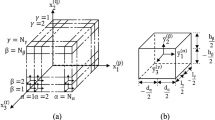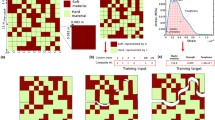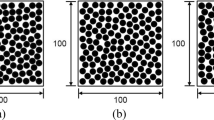Abstract
This paper presents a rigorous and critical methodology for evaluating the performance of deep learning (DL) techniques in predicting mechanical responses within the microstructural representation of composites. In the past few years, deep learning has emerged as a powerful tool and an efficient surrogate for finite element analysis in computational mechanics. This research addresses questions regarding the suitability of common error metrics for evaluating the accuracy of DL techniques in predicting full-field mechanical responses of composites. Through comparative analysis, we evaluate the performance and identify the limitations of two DL frameworks in predicting the linear von Mises stress distribution within the microstructure of the selected fiber-reinforced composite. The first DL method is based on the residual network, while the second utilizes U-Net architecture. We use several evaluation metrics, including different types of error and statistical measures and examine their suitability. Additionally, this study also investigates the influence of the size of the training and validation dataset, ranging from 50 to 2000 samples, on the predictive performance of the employed ResNet and U-Net based approaches.










Similar content being viewed by others
Data availability
The data that support the findings of this study are available from the corresponding author upon reasonable request.
References
Wang Y, Oyen D, Guo WG, Mehta A, Scott CB, Panda N, Fernández-Godino MG, Srinivasan G, Yue X (2021) StressNet—deep learning to predict stress with fracture propagation in brittle materials. npj Mater Degrad 5(1):1–10. https://doi.org/10.1038/s41529-021-00151-y
Jiang H, Nie Z, Yeo R, Farimani AB, Kara LB (2021) StressGAN: a generative deep learning model for two-dimensional stress distribution prediction. J Appl Mech 88(5):051005. https://doi.org/10.1115/1.4049805
Feng H, Prabhakar P (2021) Difference-based deep learning framework for stress predictions in heterogeneous media. Compos Struct 269:113957. https://doi.org/10.1016/j.compstruct.2021.113957
Bhaduri A, Gupta A, Graham-Brady L (2022) Stress field prediction in fiber-reinforced composite materials using a deep learning approach. Compos B Eng 238:109879. https://doi.org/10.1016/j.compositesb.2022.109879
Yang Z, Yu CH, Guo K, Buehler MJ (2021) End-to-end deep learning method to predict complete strain and stress tensors for complex hierarchical composite microstructures. J Mech Phys Solids 154:104506. https://doi.org/10.1016/j.jmps.2021.104506
Nie Z, Jiang H, Kara LB (2020) Stress field prediction in cantilevered structures using convolutional neural networks. J Comput Inf Sci Eng 20(1):011002. https://doi.org/10.1115/1.4044097
Ammasai Sengodan G (2021) Prediction of two-phase composite microstructure properties through deep learning of reduced dimensional structure-response data. Compos B Eng 225:109282. https://doi.org/10.1016/j.compositesb.2021.109282
Sepasdar R (2021) A deep learning approach to predict full-field stress distribution in composite materials. Thesis, Virginia Tech
Yang Z, Yu CH, Buehler MJ (2021) Deep learning model to predict complex stress and strain fields in hierarchical composites. Sci Adv 7(15):eabd7416. https://doi.org/10.1126/sciadv.abd7416
Maurizi M, Gao C, Berto F (2022) Predicting stress, strain and deformation fields in materials and structures with graph neural networks. Sci Rep 12(1):21834. https://doi.org/10.1038/s41598-022-26424-3
Gupta A, Bhaduri A, Graham-Brady L (2023) Accelerated multiscale mechanics modeling in a deep learning framework. Mech Mater. https://doi.org/10.1016/j.mechmat.2023.104709
He K, Zhang X, Ren S, Sun J (2016) Deep residual learning for image recognition. In: 2016 IEEE conference on computer vision and pattern recognition (CVPR), pp 770–778. https://doi.org/10.1109/CVPR.2016.90
Ronneberger O, Fischer P, Brox T (2015) U-Net: convolutional networks for biomedical image segmentation. In: Navab N, Hornegger J, Wells WM, Frangi AF (eds) Medical image computing and computer-assisted intervention—MICCAI, pp 234–241. https://doi.org/10.1007/978-3-319-24574-4_28
Isola P, Zhu JY, Zhou T, Efros AA (2017) Image-to-image translation with conditional adversarial networks. In: 2017 IEEE conference on computer vision and pattern recognition (CVPR), pp 5967–5976. https://doi.org/10.1109/CVPR.2017.632
Hu J, Shen L, Sun G (2018) Squeeze-and-excitation networks. In: 2018 IEEE/CVF conference on computer vision and pattern recognition, pp 7132–7141. https://doi.org/10.1109/CVPR.2018.00745
Shakiba M, Brandyberry DR, Zacek S, Geubelle PH (2019) Transverse failure of carbon fiber composites: analytical sensitivity to the distribution of fiber/matrix interface properties. Int J Numer Meth Eng 120(5):650–665. https://doi.org/10.1002/nme.6151
Shakiba M (2021) Detecting transverse cracks initiation in composite laminates via statistical analysis of sensitivity data. Mech Res Commun 115:103701. https://doi.org/10.1016/j.mechrescom.2021.103701
Sepasdar R, Shakiba M (2022) Micromechanical study of multiple transverse cracking in cross-ply fiber-reinforced composite laminates. Compos Struct 281:114986. https://doi.org/10.1016/j.compstruct.2021.114986
Hernández L, Sepasdar R, Shakiba M (2020) Sensitivity of crack formation in fiber-reinforced composites to microstructural geometry and interfacial properties. In: American society for composites, thirty-fifth technical conference
Ayachit U (2015) The ParaView guide: a parallel visualization application. Kitware Inc, Clifton Park
Acknowledgements
The authors gratefully acknowledge the support from the Air Force Office of Scientific Research (AFOSR) Young Investigator Program (YIP) award #FA9550-20-1-0281.
Author information
Authors and Affiliations
Contributions
MY: Conceptualization, Methodology, Software, Writing—original draft. MS: Conceptualization, Writing review and editing, Supervision, Funding acquisition.
Corresponding author
Ethics declarations
Conflict of interest
The authors declare that they have no known competing financial interests or personal relationships that could have appeared to influence the work reported in this paper
Additional information
Publisher's Note
Springer Nature remains neutral with regard to jurisdictional claims in published maps and institutional affiliations.
Supplementary Information
Below is the link to the electronic supplementary material.
Rights and permissions
Springer Nature or its licensor (e.g. a society or other partner) holds exclusive rights to this article under a publishing agreement with the author(s) or other rightsholder(s); author self-archiving of the accepted manuscript version of this article is solely governed by the terms of such publishing agreement and applicable law.
About this article
Cite this article
Yacouti, M., Shakiba, M. Performance evaluation of deep learning approaches for predicting mechanical fields in composites. Engineering with Computers (2024). https://doi.org/10.1007/s00366-024-01966-4
Received:
Accepted:
Published:
DOI: https://doi.org/10.1007/s00366-024-01966-4




